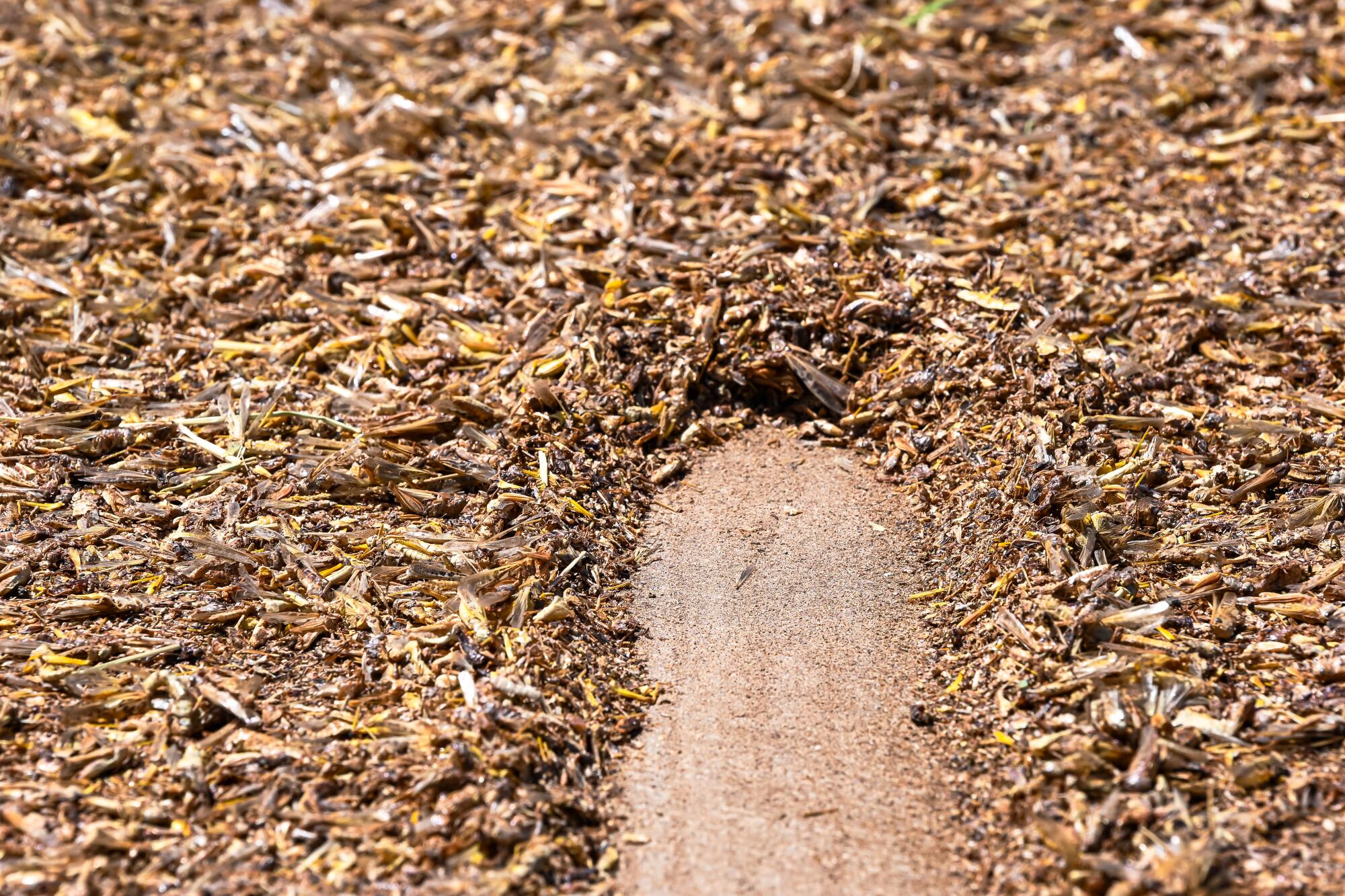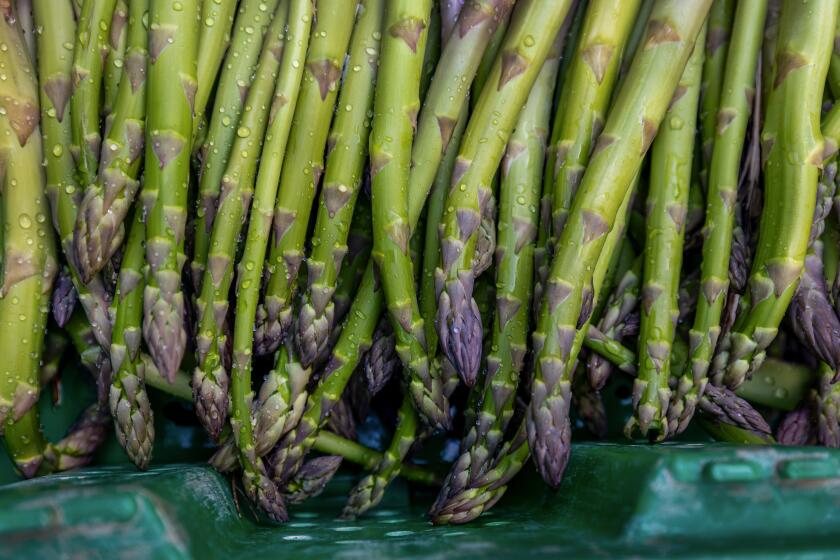
When a torrent of grasshoppers devoured more than 100,000 acres of grass pastures and rangeland three years ago in the state’s northeast, Mike McKoen felt bad for the cattle ranchers who took a financial hit. But the third-generation farmer didn’t worry much about his family farm, where they grow crops such as onions, potatoes and wheat.
“They don’t like onions,” an entomologist told him about the grasshoppers. He explained that the insect prefers to feed on nonirrigated drylands where cattle graze.
But last year, swarms of grasshoppers attacked McKoen’s onions. They chewed on the stalks, leaving behind holes where irrigation water seeped in, causing fungal and bacterial disease to spread. He spent nearly $100,000 to rescue his crops.
Hundreds of farmers and ranchers lost a good portion of their crops, resulting in millions of dollars in damage, scientists and government officials reported.
Now, the grasshoppers, which can travel long distances and decimate crops in their path, are making another unwelcome appearance in the state’s far north.
At the turn of the 21st century, California growers were farming more than 36,000 acres of asparagus. Now, fewer than 3,000 acres are in production in the state for commercial sale. These are the last three farms.
“The population of grasshoppers in the region have increased in size, scope and density in recent years,” said Rob Wilson, a University of California Cooperative Extension livestock and natural resource advisor in Tulelake.
Wilson, who specializes in pest management, said drought and government policies limiting allocation of water to farms, ranches and wetlands are to blame for the increase of grasshoppers.
By mid-July, thousands of grasshoppers take flight, and can migrate several miles. In the fields, they are camouflaged and eat everything in their path. But when they’re out and about they become a nuisance in daily life. For instance, one can’t go outside without several crashing into your face. They’re such a problem that McKoen’s family and other locals try to stay indoors.
‘Sometimes it’s like hail’
In the evenings on his way home from the ranch, McKoen is careful to drive slowly because the multitude of grasshoppers crash into his windshield and side windows, impeding his vision of the road ahead.
“It’s like rice hitting your windshield,” he said. “Sometimes it’s like hail.”
Some farmers have lost up to 70% of their hay crop in past years, said Laura Snell, a University of California Cooperative Extension livestock and natural resource advisor in Modoc County who is based in Alturas, a rural town in the state’s northeast that is about an hour’s drive from the Oregon border.
Grasshoppers can consume 30% to 250% of their body weight per day, Wilson said. Thirty pounds of grasshoppers can eat the same amount of plants as a 600-pound cow per day, he explained.
“I think this could be our worst year yet,” Snell said.
Officials in at least seven states in the West have reported invasions of grasshoppers and Mormon crickets, another insect that can destroy crops and other vegetation. Some of the most severely affected areas are in drought-stricken Northern California and eastern and central Oregon.
The Carranza family worked on the McGrath Family Farm for more than 20 years. Just as they sought to go into the strawberry business on their own, the coronavirus hit.
The grasshopper surge adds additional pressures on Northern California beef producers and crop farmers.
The grasshoppers, which lay eggs in the fall and begin hatching by summer, particularly like to eat hay and grasses — such as alfalfa — which many ranchers grow to feed their cattle. In response, many ranchers have reduced their herds because of the grasshopper destruction of their feed, said Brian Ingraham, a fourth-generation cattle rancher in Modoc County.
“For 75 years we were always able to raise enough hay to feed the number of livestock we had,” he said. “The last three or five years, we’ve had to purchase,” cutting into the ranch’s bottom line.
In response, Ingraham sold off some of his cattle, reducing the herd from 150 mother cows to 100.
High beef prices
Fewer mother cows means there are fewer to breed calves, which means there aren’t enough cattle born to replace those going to market.
Eventually, if enough ranchers reduce their herds, beef inventory decreases throughout the supply chain, forcing prices to rise.
The latest Consumer Price Index report from the Bureau of Labor Statistics shows beef and veal prices in May of this year up 5.7% compared with May 2023. More specifically, ground beef is up 4.9%, beef roasts 6% and beef steaks are up 5.7%.
High feed prices partnered with high interest rates have made cattle farming costly, according to various reports. In response, cattle ranchers have reduced the size of their herds and some have gotten out of the business altogether.
Currently, cattle inventory is the smallest it’s been since the 1950s. Despite high beef prices, American appetite for beef hasn’t dwindled. Low supply and high demand have forced prices higher.
It’s difficult to calculate how much the grasshopper destruction affects beef prices, said UCCE farm advisor Wilson.
“Beef prices are up in general,” he said. “And if you just look West-wide, [beef] cattle numbers are way down due to the drought and other issues. The grasshoppers are just another factor that puts a strain on the beef producer and does increase prices.”
Beef from the region ends up on dinner tables across the nation, including those in Los Angeles, said Carolyn Carey, a board member on the California Beef Council.
Grasshopper damage to cattle feed is a concern but, for now, fuel prices are putting more pressure on cattle ranchers’ bottom line, said Carey, who runs a cattle ranch near the town of Alturas.
In the past, the grasshoppers were a problem in dry fields and generally stayed away from irrigated lands. But that’s changed, said Wilson, who is also director of the University of California Agriculture and Natural Resources, Intermountain Research & Extension Center in Tulelake.
Last year grasshoppers traveled 10 to 20 miles into the irrigated lands, Wilson said.
“You have farmers who have been dealing with drought water curtailment for the last five years,” he said. “They’ve really suffered from that and then you add this biblical grasshopper deal? It’s been a little bit overwhelming.”
Vintners and conservationists in Valle de Guadalupe are concerned that a tourism boom and water scarcity will lead to disaster.
Since early April, Wilson has scouted and monitored the grasshoppers near Tule Lake, an ancient lake that has come under threat after several years of drought. He’s found that there are more than eight immature grasshoppers per square yard in more than 50,000 acres he’s surveyed around the lake. More than eight is the threshold that indicates economic damage.
“The numbers are quite alarming,” Wilson said. “In some cases there are 20 to 30 nymph per square yard. There’s potential for a lot of problems.”
Grasshoppers tend to be cyclical, but there wasn’t much of a problem in the region until four years ago, Snell said.
A series of drought years made for prime nursery grounds for grasshoppers, which flourish in dry land. They’re particularly vulnerable to natural fungi and diseases in humid and wetter conditions.
“But when it’s dry, those natural barriers that prevent them from becoming a problem aren’t there,” Snell said.
County officials, farm advisors, farmers and ranchers have asked the state for grasshopper treatments. They’ve petitioned the U.S. Department of Agriculture Animal Plant Health Inspection Service (USDA APHIS), which operates an abatement program in several states and on federal lands, using treatments to kill a majority of the grasshoppers but still leaving enough for natural predators that feed on them. USDA APHIS also shares costs for treatment of private lands bordering federal lands.
Since 2021, the agricultural community in the region has been in conversations with the agency about the need for grasshopper treatments in the affected counties in the state.
Snell and Wilson said they haven’t gotten very far.
The bugs return
Modoc County Farm Bureau President Sean Curtis said California discontinued its abatement program more than 50 years ago because the grasshoppers had stopped becoming an issue until their recent return, Snell said.
It’s been difficult to get it back.
There are several methods used to prevent the proliferation of grasshoppers, such as certain pesticides that can be sprayed in their infant stage. But those chemicals are pricy and, some say, not worthwhile because every single landowner would need to spray for it to be effective.
You need widespread treatment, Ingraham argued.
“If all the landowners aren’t doing it,” Ingraham said, “they just move right on into the food source where we’ve already mitigated.”
Ingraham’s land borders other private land and federal land. He used to spray but no longer does. The insecticides kill the grasshoppers on his land but days later, he said, the voracious grasshoppers from neighboring land will just fly in and eat what’s on his ranch.
“It’s shooting ourselves in the foot, pouring money down the rat hole,” he said of treating his land with insecticides. “We’ll just take our licks as they come.”
More to Read
Eat your way across L.A.
Get our weekly Tasting Notes newsletter for reviews, news and more.
You may occasionally receive promotional content from the Los Angeles Times.














